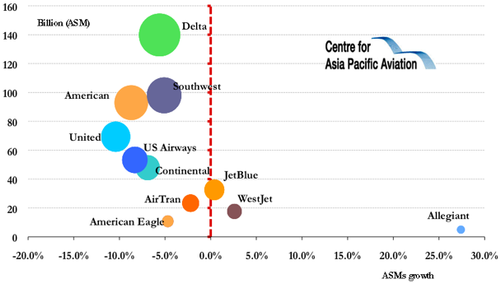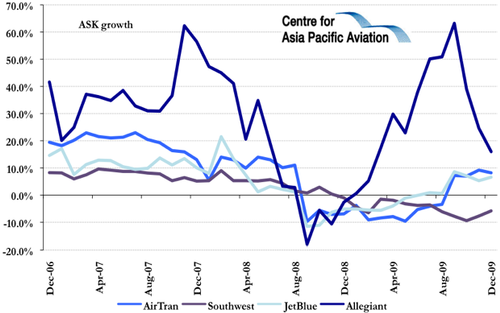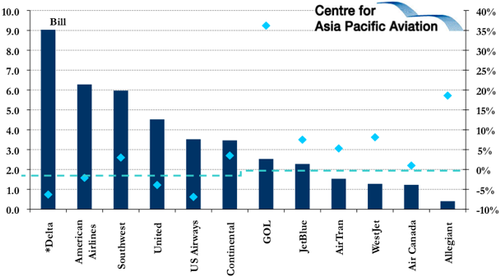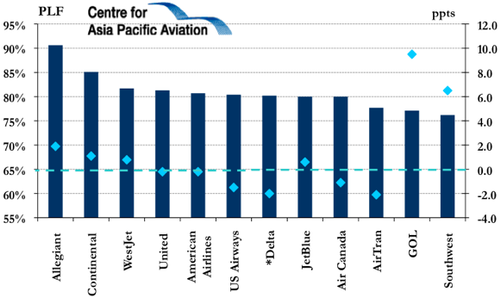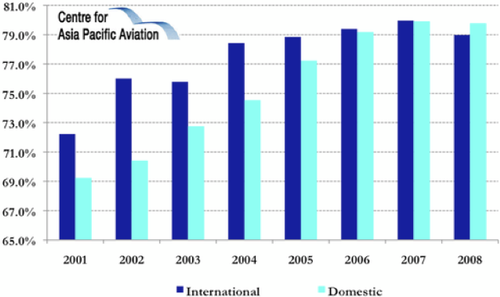A more positive picture for US airlines in Dec-2009, but times remain tough
2009 ended much better than it started for US airlines, with Dec-2009's traffic results confirming some yield improvements, rising demand and load factors hovering around the 80% mark domestically. These improvements have been driven by careful capacity management and a slow pick up in air travel demand, reflecting the underlying economic recovery.
This article features in Peanuts! Weekly - the only publication exclusively focused on analysing global LCC strategy.
According to the ATA, passenger revenue fell 7% in Nov-2009, marking the 13th consecutive month in which passenger revenue has declined from the prior year, fuelled primarily by the 12th consecutive month of ticket price declines. But it was an improvement on the mid-year lows.
The lucrative business market, while improving, is yet to return to pre-crisis levels, putting further pressures on profitability and revenues as we enter 2010.
See related article: Southwest trumps JetBlue, US Airways and Continental in the yield growth stakes in Dec-2009
Capacity reduced by the majority in FY2009
During 2009, the nation's six largest airlines all reported capacity reductions, with only JetBlue and SkyWest reporting marginal capacity increases in the year among the nation's nine largest airlines.
North American carriers' domestic passenger capacity growth (% change year-on-year): 2009
Among the smaller carriers, Allegiant, which has been robust throughout the global economic slowdown, stood out again. Allegiant's expansionist strategy saw the carrier increase scheduled service capacity by over 27% in the full year.
Capacity (ASKs) growth for AirTran, Southwest, JetBlue and Allegiant: Dec-2006 to Dec-2009
Dec-2009 capacity: Increased by some but off a weak base
A number of US carriers are starting to come out of their shells. In Dec-2009, carriers like Continental and American Eagle were again reporting growth in capacity levels, although this came off a weak base in Dec-2008.
North American carriers' domestic passenger capacity growth (% change year-on-year): Dec-2009
LCCs driving traffic growth in Dec-2009
While Allegiant was again the notable standout in terms of its growth profile, AirTran increased capacity the most among the majors last month, setting new December records for traffic, capacity and enplaned passengers in Dec-2009. AirTran's traffic (RPMs) increased 5.3% on a 8.2% capacity (ASMs) increase, and the number of enplaned passengers rose 1.7% to over 1.9 million.
JetBlue's traffic (RPMs) (and passenger) growth in Dec-2009 was the highest among the major carriers in the US domestic market, with the other US LCCs also increasing traffic in the month, indicating that it is the LCCs leading the US industry back to growth.
Select US airline traffic (RPMs) and traffic growth (%): Dec-2009
Load factor improvements across the board (with the exception of Delta and JetBlue) in FY2009
All but two of the nine US majors (with the exception of Delta and JetBlue) reported load factor improvements in the full year of 2009, reflecting continued capacity reductions and signs of a bottoming in demand. Delta and JetBlue reportedly marginals load factor reductions, slipping 0.1 ppts and 0.7 ppts, respectively.
Load factors among the major US airlines were strong in the year, in the 76% to 85% range.
US airlines domestic traffic^ highlights: FY2009
|
|
Traffic (RPMs) (bill) |
% Change |
Capacity (ASMs) (bill) |
% Change |
Load factor (%) |
% Change |
Traffic - pax (mill) |
% Change |
|---|---|---|---|---|---|---|---|---|
|
Delta/Northwest |
115.9 |
-5.8% |
139.8 |
-5.6% |
82.9% |
-0.1 ppts |
n/a |
n/a |
|
76.7 |
-7.9% |
92.9 |
-8.7% |
82.6% |
+0.8 ppts |
n/a |
n/a |
|
|
74.5 |
+1.3% |
98.0 |
-5.1% |
76.0% |
+4.8 ppts |
101.3 |
-0.6% |
|
|
58.0 |
-9.2% |
69.3 |
-10.4% |
83.7% |
+1.1 ppts |
n/a |
n/a |
|
|
44.3 |
-7.5% |
53.3 |
-8.3% |
83.2% |
+0.7 ppts |
45.2 |
-8.1% |
|
|
40.6 |
-5.3% |
47.9 |
-6.9% |
84.8% |
+1.5 ppts |
n/a |
n/a |
|
|
26.0 |
-0.4% |
32.6 |
+0.4% |
79.7% |
-0.7 ppts |
22.4 |
+2.4% |
|
|
AirTran |
18.6 |
-1.9% |
23.3 |
-2.2% |
79.8% |
+0.2 ppts |
24.0 |
-2.5% |
|
SkyWest |
17.4 |
+2.0% |
22.1 |
+0.6% |
78.8% |
+1.1 ppts |
34.5 |
+3.2% |
The same load factor range was apparent in Dec-2009.
US airlines domestic traffic^ highlights: Dec-2009
|
|
Traffic (RPMs) (bill) |
% Change |
Capacity (ASMs) (bill) |
% Change |
Load factor (%) |
% Change |
Traffic - pax (mill) |
% Change |
|---|---|---|---|---|---|---|---|---|
|
Delta/Northwest |
9.0 |
-6.3% |
11.3 |
-4.0% |
80.2% |
-2.0 ppts |
n/a |
n/a |
|
6.3 |
-2.1% |
7.8 |
-1.8% |
80.7% |
-0.2 ppts |
n/a |
n/a |
|
|
6.0 |
+3.0% |
7.8 |
-5.8% |
76.2% |
+6.5 ppts |
8.4 |
+4.9% |
|
|
4.5 |
-3.9% |
5.6 |
-3.7% |
81.3% |
-0.2 ppts |
n/a |
n/a |
|
|
3.5 |
-6.9% |
4.4 |
-5.1% |
80.4% |
-1.5 ppts |
3.6 |
-8.4% |
|
|
3.5 |
+3.5% |
4.1 |
+2.2% |
85.1% |
+1.1 ppts |
n/a |
n/a |
|
|
2.3 |
+7.5% |
2.8 |
+6.6% |
80.0% |
+0.6 ppts |
2.0 |
+6.4% |
|
|
AirTran |
1.5 |
+5.3% |
2.0 |
+8.2% |
77.7% |
-2.1 ppts |
2.0 |
+1.7% |
|
SkyWest |
1.4 |
+5.4% |
1.8 |
+6.5% |
77.4% |
-0.8 ppts |
2.8 |
+6.9% |
Southwest's load factors remain the weakest in Dec-2009, but the most improved
As is usually the case, Southwest's load factors remained the weakest among the major US airlines in Dec-2009 (AirTran and SkyWest's load factors also fell below 80% in the month). But Southwest is working hard in this area. In Dec-2009, Southwest's load factors rose an impressive 6.5 ppts for six consecutive months of healthy load factor gains, and for the largest load factor gain among the US airlines.
Select US airline load factor (%) and load factor growth (ppts): Dec-2009
US network carriers' occupancy levels higher than their LCC counterparts
Another noticeable trend that has emerged is that America's network airlines have pared back capacity so much that they are now consistently operating with similar or even higher load factors than their point-to-point LCC competitors. Accordingly, the US domestic industry has seen a 10-11% load factor increase for 2008 over 2001 levels. This is an extraordinary achievement.
US carriers international and domestic passenger load factor: 2001 to 2008
Unfavourable gap between average break even and actual load factors still exists, but reduced in 3Q2009
The Air Transport Association of America (ATA), in its quarterly Airline Cost Index for 3Q2009, revealed a 36% reduction in the cost index to 185.3, easily outpacing the 1.6% decline in the US Consumer Price Index (CPI). This helped reduce - "but not eliminate" - the unfavourable gap between average break-even and actual load factors, which fell from 6.2 ppts to 0.8 ppts.
The three largest components of the index - which includes all operating expenses as well as interest expense - were labour, fuel and transport-related costs, respectively.
ATA 3Q2009 Airline Cost Index
|
Cost area |
Increase |
|---|---|
|
Aircraft insurance |
+53% |
|
Interest |
+18% |
|
Maintenance material (cost of maintaining/purchasing materials for airframes, aircraft engines, ground property & equipment) |
+17% |
|
Advertising and promotion |
+5% |
|
Landing fees |
+3% |
|
Transport-related expenses |
-18% |
|
Professional services |
-16% |
|
Communication |
-9% |
|
Non-aircraft insurance |
-9% |
|
Utilities and office supplies |
-7% |
|
Property rents and ownership |
-5% |
|
Travel agency commissions |
-4% |
|
Food and beverage |
-1% |
ATA Chief Economist, John Heimlich, commented, "with heightened security measures in place, security costs looming, a fragile economic recovery and continued job losses reported by the Bureau of Labor Statistics within the past week, airlines remain intensely focused on reducing expenses and pursuing additional sources of revenue. Cost discipline remains paramount amid historically weak demand for air travel and the return to USD80-plus crude oil."
Outlook: Passenger numbers beginning to stabilise; a gradual recovery underway?
ATA President, James C May, in Dec-2009, expressed optimism and caution about the outlook for 2010, commenting that passenger numbers among US carriers are "beginning to stabilise after several months of pronounced declines", adding, "hopefully this is an indication that a gradual recovery is under way".
Carriers are likely to cautiously increase capacity on a year-on-year basis in 2010, after the deepest capacity reductions since 1942 by US airlines last year.
Capacity is expected to continue to be reduced in Jan-2010, according to OAG, with the number of services within North America expected to decrease by 2.7% in Jan-2010 (to 22.826 flights) with 2.8% fewer seats in the month (to 2.5 million).
Strict capacity management has meant that US airlines are operating at near record load factors, which is helping to push yields off the floor. Whether the positive trends can be maintained depends on the strength of the US economy, whose outlook is still uncertain.
